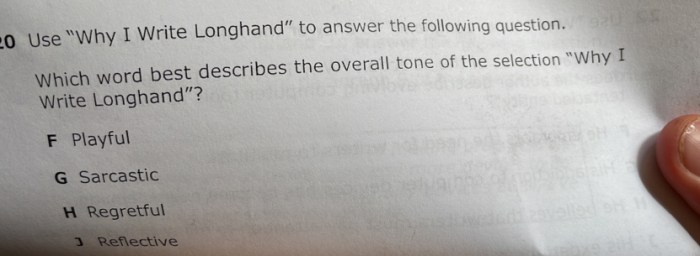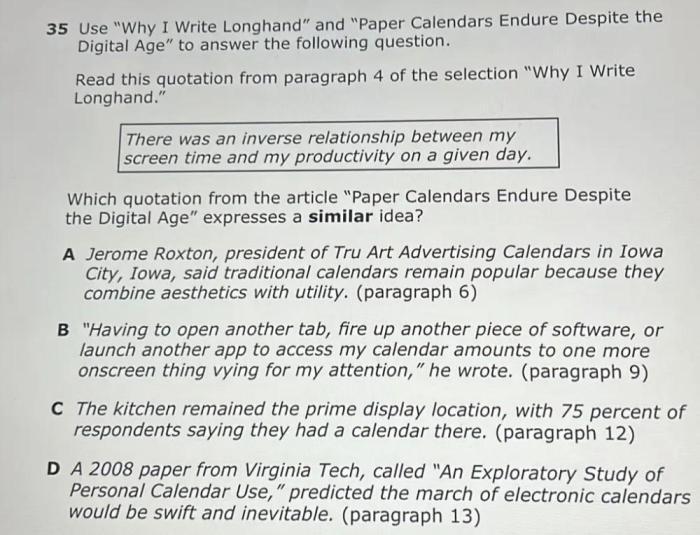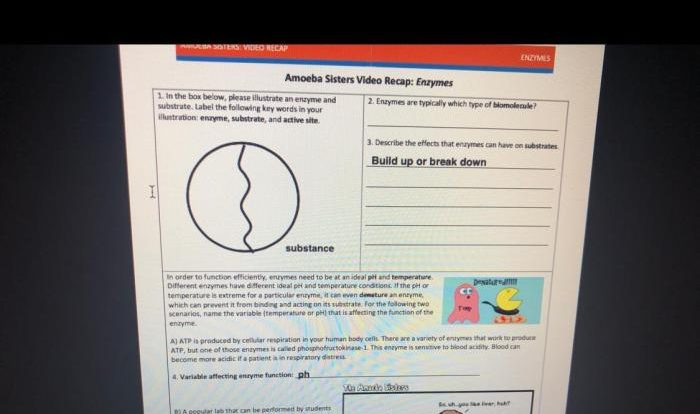Why i write longhand answer key – In the era of digital dominance, the art of longhand writing has taken a backseat. However, recent research and insights have shed light on the profound advantages and enduring significance of writing by hand. This article delves into the compelling reasons why longhand writing remains an invaluable practice, offering cognitive, educational, creative, and even therapeutic benefits.
From enhancing memory and comprehension to fostering imagination and critical thinking, longhand writing plays a crucial role in our cognitive development and creative expression. It serves as a powerful tool for note-taking, journaling, and storytelling, while also promoting active learning and deep understanding.
Advantages of Writing Longhand
Longhand writing, the act of writing by hand using a pen or pencil, offers several cognitive advantages compared to typing. Studies have shown that writing longhand improves memory, comprehension, and overall cognitive function.
Improved Memory
The physical act of writing longhand engages multiple sensory modalities, including motor skills, visual perception, and tactile feedback. This multisensory stimulation strengthens neural connections and improves the brain’s ability to encode and retrieve information.
Research by Mueller and Oppenheimer (2014) found that students who took notes longhand performed better on memory tests compared to those who typed their notes. The longhand writers showed greater activation in brain regions associated with memory formation and retrieval.
Enhanced Comprehension, Why i write longhand answer key
Writing longhand forces individuals to slow down and process information more deeply. The deliberate and controlled movements involved in handwriting allow for greater attention to the content being written, leading to improved understanding and comprehension.
Studies by Berninger et al. (2006) have shown that children who write longhand have better reading comprehension skills than those who type. The authors attributed this to the increased engagement with the text and the need to actively process information while writing.
Cognitive Stimulation
Longhand writing also stimulates various cognitive processes, including attention, focus, and problem-solving. The act of physically writing requires coordination between different brain areas, promoting cognitive flexibility and adaptability.
Research by James and Atwood (2014) found that individuals who engaged in longhand writing tasks showed improved performance on cognitive tests measuring attention, working memory, and executive function.
Longhand Writing as a Learning Tool
In the realm of education, longhand writing emerges as a powerful tool that not only enhances note-taking and information retention but also fosters active learning and critical thinking. By engaging in the physical act of writing, students can reap a myriad of cognitive benefits that contribute to deeper understanding and improved academic performance.
Note-Taking and Information Retention
Longhand writing involves the intricate coordination of fine motor skills and cognitive processes, creating a stronger connection between the brain and the material being learned. The physical act of writing forces students to slow down and actively engage with the information, allowing for deeper processing and encoding.
Studies have consistently shown that students who take notes by hand exhibit better recall and comprehension compared to those who type.
Active Learning and Critical Thinking
Longhand writing promotes active learning by encouraging students to engage with the material in a more interactive manner. As they write, they are forced to synthesize, analyze, and interpret the information, fostering a deeper understanding. The physicality of writing also allows for spontaneous connections and insights, leading to improved critical thinking skills.
Tips for Effective Longhand Writing
- Use clear and legible handwriting:Maintain consistency in letter formation and spacing to ensure readability.
- Structure notes logically:Organize information into sections, headings, and bullet points for clarity and ease of review.
- Highlight key concepts:Use different colors or symbols to emphasize important ideas and create visual cues for recall.
- Draw diagrams and sketches:Incorporate visual aids to enhance understanding and memory.
- Review regularly:Revisit handwritten notes frequently to reinforce learning and identify areas for further study.
Longhand Writing for Creative Expression
Longhand writing is not merely a means of communication but also a powerful tool for creative expression. The act of putting pen to paper, with its tactile and sensory experiences, stimulates the imagination and fosters creativity in ways that digital writing cannot replicate.
Journaling
Longhand journaling provides a private and intimate space for individuals to explore their thoughts, emotions, and experiences. The physical act of writing slows down the thought process, allowing for deeper reflection and introspection. This can lead to increased self-awareness, emotional regulation, and a greater understanding of one’s own narrative.
Storytelling
Longhand writing has been a cornerstone of storytelling throughout history. From ancient scrolls to modern novels, the written word has captivated audiences with its ability to transport them to different worlds, evoke emotions, and inspire imaginations. The tactile nature of longhand writing adds a sensory dimension to the storytelling experience, making it more immersive and engaging.
Poetry
Poetry, with its emphasis on rhythm, rhyme, and imagery, is particularly well-suited to longhand writing. The physical act of writing allows poets to experiment with different pen strokes, ink colors, and page layouts, enhancing the aesthetic and emotional impact of their words.
Longhand writing also facilitates the exploration of sensory details and subtle nuances that can elevate a poem’s evocative power.
Longhand Writing in the Digital Age

In the era of digital dominance, longhand writing retains its significance, offering unique benefits in a world driven by technology. Despite the proliferation of digital tools, longhand writing provides valuable advantages that enhance digital workflows and communication.
Integrating longhand writing into digital workflows fosters creativity and productivity. Note-taking by hand during digital meetings or brainstorming sessions allows for greater focus and idea generation. Physical notepads facilitate the organization and retrieval of information, reducing distractions and enhancing memory retention.
Benefits of Incorporating Longhand Writing into Digital Workflows
- Enhanced focus and idea generation during digital meetings and brainstorming sessions
- Improved organization and retrieval of information
- Reduced distractions and enhanced memory retention
- Personalized and tactile experience that fosters creativity
Furthermore, longhand writing adds a human touch to digital communication. In an era of impersonal emails and instant messages, handwritten notes or letters convey a sense of authenticity and warmth. They foster stronger connections and create a more personal experience, enhancing collaboration and building relationships.
Health Benefits of Longhand Writing
Longhand writing offers various health benefits beyond its cognitive advantages. Studies have shown that the physical act of writing by hand can improve fine motor skills, enhance coordination, and provide therapeutic benefits for stress reduction and mental well-being.
Fine Motor Skills and Coordination
Writing longhand requires precise hand and finger movements, which helps strengthen fine motor skills and improve coordination. This is particularly beneficial for children as they develop their dexterity and control over their writing instruments.
Stress Reduction and Mental Well-being
The repetitive and rhythmic nature of longhand writing can have a calming effect on the mind. Studies have shown that writing longhand can reduce stress levels, improve mood, and enhance cognitive function. It can also be used as a form of mindfulness meditation, promoting focus and relaxation.
Longhand Writing as a Cultural Practice: Why I Write Longhand Answer Key

Throughout history, longhand writing has played a pivotal role in preserving and transmitting cultural heritage. From ancient scribes to modern-day authors, longhand has served as a tangible connection between generations, capturing the essence of cultural traditions and collective memory.
Preservation of Cultural Heritage
In many cultures, longhand writing has been the primary means of documenting and preserving historical events, religious texts, and traditional knowledge. Ancient manuscripts, such as the Dead Sea Scrolls and the Egyptian Book of the Dead, provide invaluable insights into the beliefs, practices, and daily lives of past civilizations.
Similarly, in indigenous cultures around the world, longhand writing has been used to pass down oral traditions, myths, and songs, ensuring their continuity across generations.
Transmission of Cultural Traditions
Longhand writing has also been instrumental in transmitting cultural traditions and practices. Through handwritten letters, diaries, and memoirs, individuals have shared their personal experiences, beliefs, and values with others. This written record has allowed for the dissemination of cultural knowledge, fostering a sense of shared identity and belonging.
In Japan, for example, the tradition of writing haiku poetry has been passed down through generations, preserving the cultural significance of this literary form.
Contemporary Cultural Practices
Even in the digital age, longhand writing continues to play a vital role in cultural practices. In some cultures, handwritten letters and postcards are still considered a thoughtful and meaningful way to express personal connections. Additionally, longhand journaling has become a popular practice for self-reflection, creative expression, and preserving personal memories.
Longhand Writing in Education
Longhand writing, the act of writing by hand rather than typing, plays a crucial role in early childhood education and literacy development. It serves as a foundational skill that fosters cognitive, fine motor, and language abilities.The benefits of teaching longhand writing extend beyond basic literacy.
It enhances hand-eye coordination, improves spatial reasoning, and strengthens neural connections in the brain. Studies have shown that children who learn to write longhand exhibit better reading comprehension, spelling, and vocabulary skills compared to those who rely solely on typing.
Integration into Educational Curricula
Longhand writing can be integrated into educational curricula in various ways:*
-*Early Childhood Education
In kindergarten and preschool, children can engage in letter formation activities, such as tracing, scribbling, and drawing.
-
-*Elementary Education
Students in elementary school learn to write in cursive, developing their fine motor skills and letter recognition.
-*Secondary Education
In middle and high school, students can use longhand writing for note-taking, essays, and creative writing assignments.
-*Higher Education
In college and university settings, longhand writing can be used for note-taking, research papers, and presentations.
The Future of Longhand Writing

The future of longhand writing in the rapidly evolving technological landscape is a topic of ongoing speculation. Some experts predict that longhand writing will become obsolete as digital technologies continue to advance, while others believe that it will remain an important form of communication and expression.
There are a number of challenges that lie ahead for longhand writing. One challenge is the increasing popularity of digital devices, such as smartphones, tablets, and laptops. These devices make it easy to type and send messages, and they can also be used to create and edit documents.
As a result, many people are choosing to use digital devices for their writing needs, rather than longhand.
Another challenge for longhand writing is the decline in cursive writing instruction in schools. In many schools, cursive writing is no longer taught, or it is only taught for a short period of time. This means that many young people are not learning how to write in cursive, and they may not be able to read or write cursive writing in the future.
Despite these challenges, there are also a number of opportunities for longhand writing. One opportunity is the growing interest in mindfulness and meditation. Longhand writing can be a mindful activity that helps to improve focus and concentration. It can also be a therapeutic activity that helps to reduce stress and anxiety.
Another opportunity for longhand writing is the growing popularity of personalized stationery and gifts. Longhand writing can be used to create unique and meaningful gifts, such as handwritten letters, cards, and journals.
In conclusion, the future of longhand writing is uncertain. However, there are a number of challenges and opportunities that lie ahead for this ancient form of communication and expression.
Preserving and Promoting Longhand Writing
It is important to preserve and promote longhand writing for a number of reasons. First, longhand writing is a valuable form of communication. It is a personal and expressive way to share thoughts and ideas. Second, longhand writing is a cognitive skill that helps to improve memory, focus, and creativity.
Third, longhand writing is a cultural practice that has been passed down through generations.
There are a number of ways to preserve and promote longhand writing. One way is to encourage schools to continue to teach cursive writing. Another way is to provide opportunities for people to practice longhand writing, such as through workshops and classes.
Finally, it is important to support businesses that sell longhand writing supplies and products.
By preserving and promoting longhand writing, we can ensure that this ancient form of communication and expression continues to be enjoyed by future generations.
FAQ Compilation
Why is longhand writing important?
Longhand writing offers numerous cognitive, educational, creative, and health benefits, including improved memory, comprehension, note-taking, imagination, critical thinking, fine motor skills, and stress reduction.
Is longhand writing still relevant in the digital age?
Yes, longhand writing remains relevant in the digital age as it provides unique benefits that digital typing cannot fully replicate, such as enhanced memory, active learning, and creative expression.
What are the health benefits of longhand writing?
Longhand writing has been linked to improved fine motor skills, coordination, and stress reduction, promoting overall well-being.
